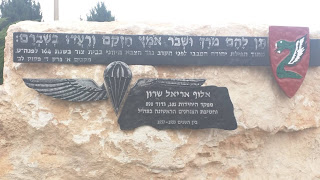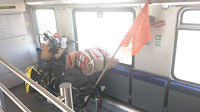Zikkim Dunes – Gaza Border area – Sderot – Tel Aviv (Israel)
 About 2am, after fitfully dozing off and on for a few hours, I finally have had enough of the nearby beach party. The Mizrachi pop music is blasting away with no end in sight. Avi is also up and we agree it’s time to go. Twenty minutes later we are packed and say our goodbyes, resolving to stay in touch. The ride back up the hill is pleasant with a quarter moon lighting the way. However I add my extra camping light to the front of the bike since people are driving to and fro from the beach party and some of them have likely had too much to drink. After circling around the perimeter of Kibbutz Zikkim, I take route 4 south to Erez Crossing, the only checkpoint where people with special permits may go in or out of Gaza.
About 2am, after fitfully dozing off and on for a few hours, I finally have had enough of the nearby beach party. The Mizrachi pop music is blasting away with no end in sight. Avi is also up and we agree it’s time to go. Twenty minutes later we are packed and say our goodbyes, resolving to stay in touch. The ride back up the hill is pleasant with a quarter moon lighting the way. However I add my extra camping light to the front of the bike since people are driving to and fro from the beach party and some of them have likely had too much to drink. After circling around the perimeter of Kibbutz Zikkim, I take route 4 south to Erez Crossing, the only checkpoint where people with special permits may go in or out of Gaza.Not many permits are issued these days. No tourists of course, but journalists or foreigners with accreditation to NGOs, or government agencies may apply for a permit to enter. A handful of Palestinians get permits for medical reasons but often the Israeli security services will pressure them to become an informant in order to approve a permit. Just another aspect of our intractable problems.
It’s a bit eerie as I cycle slowly into the security zone approaching the checkpoint. On both sides are concrete walls, coils of barbed wire, bunkers and guard towers. It’s like a fortress. The border is closed of course since it’s just 4am. I can feel the eyes on me from the towers, and the snipers taking a bead. With both hands visible, I don’t stop or make sudden moves but just cycle slowly into the car park next to the main gate, circle around it and start to exit. Then I hear a disembodied voice from a nearby concrete bunker. “Ma Coray?” (“what’s up?”) says the voice? I peer through the dark opening and make out three silhouettes inside, likely with guns at the ready. “Just taking a look around” I say cheerily in English. “OK” comes back at me with a dubious tone. Since I was not ordered to stop, I keep cycling slowly out of the checkpoint zone. After a few hundred meters I hear a vehicle coming up behind me. Oops, I guess they want a chat, so I stop. But no, it’s not a military vehicle and just keeps going. I go back to route 4 heading south.
 Since I did not make coffee before breaking camp I pause at a closed gas station and avail myself of their picnic table and fire up the stove. Dawn is breaking. The birds are twittering and the coffee tastes good. It’s still a bit early but I decide breakfast is in order, so I cut up some fruit and have it with granola and fresh OJ, yummy.
Since I did not make coffee before breaking camp I pause at a closed gas station and avail myself of their picnic table and fire up the stove. Dawn is breaking. The birds are twittering and the coffee tastes good. It’s still a bit early but I decide breakfast is in order, so I cut up some fruit and have it with granola and fresh OJ, yummy.I get back on the road and after about 15 kilometers I take the turn off to Kibbutz Nir Am and go west in the general direction of Gaza. I have already decided to set aside my original goal of going far south, and focus instead on exploring the many secondary roads to the west and south of Sderot, between Route 4 and the Gaza border. I arrive at the kibbutz gate and see another road veering off and following the outside of their perimeter fence. It looks promising since it continues west towards Gaza. The hilly countryside is a bit scrubby, except inside the kibbutz fence where intensive cultivation and irrigation has coaxed the sandy soil to life.
Shortly I arrive at the Nir Am reservoir with the Gaza fence just beyond. In the distance is the medium-rise buildings of Gaza City, and the sea beyond. I hear gunshots, small arms from the sound of it. However from the cadence of the shots, it sounds like someone is having target practice. I mount up and go in the general direction, ready to take to the ground should the gunshots prove to be hostile. I am less than one kilometer from the Gaza border. As I get closer to the sound, I see a compound with a cluster of small buildings and groups of people standing around. They are not soldiers or policemen but everyone is wearing a pistol. There are no signs. I enter a gate and ask someone what the place is – A shooting range. Makes sense. The group assembled is taking the required course before being issued with their pistol permit. I act like a foreign tourist and am asked if I was to shoot. I decline.
Further up the hill is a tall tower with soldiers. There is a large sign. NO ENTRY. The Gaza border fence is just a few hundred meters further on, but I turn around and take another small road snaking around the hills, paralleling the border. Off to the right I spy what seems like a monument with a managed wooded area next to it, picnic tables and all. I investigate. It’s the ‘Black Arrow’ memorial site. Wow! This site commemorates one of the most famous and, to some, notorious, commando units of the Israeli military, the IDF. For many Israelis, the Legendary Warriors of Unit 101, founded and led by Ariel Sharon in the 1950s, are true national heroes. To others they were state sponsored terrorists of the murdered women and children of Qibya and other Palestinian villages.
 In 1953, ‘Operation Shoshana’ in the Palestinian village of Qibya resulted in over 69 dead people, two-thirds of them women and children. The action was a combined operation of Unit 101 and Paratroop Battalion 890, and was one of the few times that the USA suspended economic aid to Israel.
In 1953, ‘Operation Shoshana’ in the Palestinian village of Qibya resulted in over 69 dead people, two-thirds of them women and children. The action was a combined operation of Unit 101 and Paratroop Battalion 890, and was one of the few times that the USA suspended economic aid to Israel.The memorial I am standing in front of commemorates the deaths of men from these units during their many ‘reprisal’ raids in retaliation for not only incursions and terror attacks by Palestinians, but also to ‘discourage’ refugees from 1948 from ‘sneaking’ back into Israel to farm their confiscated land.
In my view this memorial, while perhaps appropriately acknowledging the human tragedy of the deaths, is no different than similar Palestinian memorials to their fighters that Israel regards as terrorists. All of them senseless deaths. Senseless violence. Senseless nationalism. It all makes me sick.
I move on.
It’s now late morning and the day is proceeding slower than yesterday due to just a couple of hours sleep in 20-minute snippets. My energy, not surprisingly, is not there. I start to circle back around to the main road, and head off to Sderot, the town that has been at the forefront of small rocket attacks from extreme elements in Gaza. Few have been hurt by these home made arms, but they serve to keep the population on edge.
 On the way into Sderot I visit the railway station and discover that i am indeed able to take my bike on the train. I buy a ticket (24 shekels, about $7) and plan to take the
On the way into Sderot I visit the railway station and discover that i am indeed able to take my bike on the train. I buy a ticket (24 shekels, about $7) and plan to take the
2.50pm train. Then I head to a coffee shop for a work session. Green Olive has a large number of ongoing tours this week, and cycling or not, I still have a business to run. That’s why I set it up over the past few years as a digital company. No paper. No office. Everything in the ‘cloud’. With 9 Working Partners and 4 employees spread over three countries, my phones and laptop are enough to keep things humming along no matter where I am – so long as I have mobile data service or an internet connection, which is almost everywhere these days. Over the past year I’ve managed to run the business while on cycling trips in Ethiopia, Jordan, Shetland, and of course Palestine and Israel. This summer i’ll be cruising in the USA to visit my grandson and cycle some remote areas of Minnesota, Pennsylvania, and Colorado. Let me know if you want to connect.
After a nice vegan lunch at the coffee shop, I head back to the station for the train to Jaffa. There’s actually a train station at Holon/Wolfson, which is a 10-minute ride from my house. Security at the station is a bit cumbersome, since they have an airport-style scanner so I have to unload all the panniers off the bike, then reload the bike after security. There’s some debate about my rather large Swiss army knife, and it is only returned to me after the security guard gets approval by phone from a superior. It’s obvious that I have been camping and am not a ‘bad guy’. Then down one elevator and up the other side to the platform.
The train arrives and a railway attendant helps me make quick work of hoisting the bike aboard, bags and all. There’a a ramp to a lower deck, and after some discussion with people regarding the appropriate location for the bike, I settle in for the 90-minute ride.
The only serious mishap happened while getting off the train. I asked a fellow to hold the rear end of the bike while I navigated it down the two steps to the platform. Instead of holding the weight, he pushed the heavy bike and it collapsed on the platform half on top of me, skinning one knee and bashing the other one. Then my helper stepped around me with out a word, and strode off down the platform. What amazing is that not one person out of the dozen or so getting off the train, offered to help. All of them just stepped around me and disappeared. So I picked myself up, and the bike – a bit less sure of any compassion in Israeli society. I would have expected such behavior in a large US city, but traditionally in Israel people help out strangers in distress. Not any more it seems. Sad.
So I cycle home, happy to see my family, veggie garden, and animals. Today was only about 35 kilometers of cycling, about 125 km over the two days, but I am satisfied with the much needed 2-day break.

Comment (0)